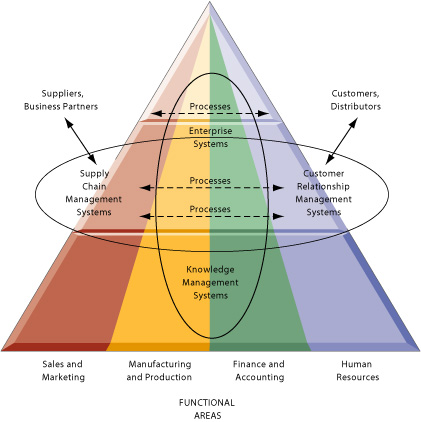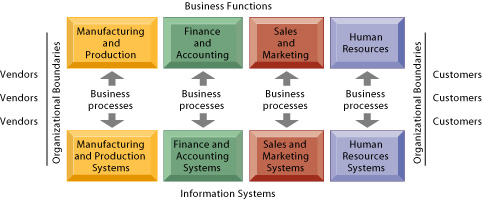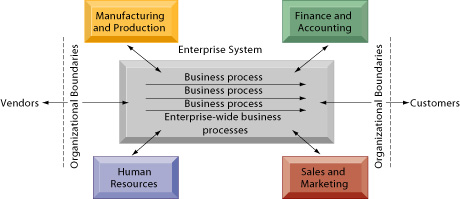Many firms are using information technology to build
systems to further integrate key internal business processes and to link
the firm's business processes to those customers, suppliers, and other
companies in its industry. Some business processes support the major functional
areas of the firm while others are cross-functional, transcending boundaries
between sales, marketing, manufacturing, and research and development.
[Figure 2-12]

|
| FIGURE
2-12 The order fulfillment process
Generating and fulfilling an order is a
multistep process involving activities performed by the sales, manufacturing
and production, and accounting functions. |
Enterprise
applications, consisting of enterprise systems and systems
for supply chain management, customer relationship management, and knowledge
management, are increasingly used for this purpose.
Deployment
of enterprise applications requires firms to think more strategically
about their business processes. Business processes are the unique ways
in which organizations coordinate and organize work activities, information,
and knowledge to produce a valuable product or service. Organizations
have business processes supporting each of the major business functions
and business processes that span multiple functions. Organizational efficiency
can be increased by automating parts of these processes or by using information
technology to redesign and streamline the processes. [Figure 2-13]

FIGURE 2-13 Enterprise application architecture
Enterprise applications automate
processes that span multiple business functions and organizational
levels and may extend outside the organization.
|
|
Enterprise
systems, or enterprise resource planning (ERP) systems model
and automate many business processes, such as filling an order or scheduling
a shipment, with the goal of integrating information across the entire
company and eliminating complex, expensive links between computer systems
in different areas of the business. Information that was previously fragmented
in different systems can seamlessly flow throughout the organization so
that it can be shared by business processes in manufacturing, accounting,
human resources, and other areas of the firm. Discrete business processes
from sales, production, finance, and logistics can be integrated into
company-wide business processes that flow across organizational levels
and functions. [Figure 2-14]

FIGURE 2-14 Traditional view of systems
In most organizations today, separate
systems built over a long period of time support discrete
business processes and discrete segments of the business
value chain. The organization’s systems rarely include
vendors and customers.
|
|
The
enterprise system collects data from various key business processes and
stores the data in a single comprehensive data repository where they can
be used by other parts of the business. Managers emerge with more precise
and timely information for coordinating the daily operations of the business
and a firm-wide view of business processes and information flows. [Figure
2-15].

FIGURE 2-15 Enterprise systems
Enterprise systems integrate the
key business processes of an entire firm into a single software
system that enables information to flow seamlessly throughout
the organization. These systems focus primarily on internal
processes but may include transactions with customers and
vendors.
|
|
| |
Supply
chain management focuses on coordinating all of the activities and information
flows involved in buying, making, and moving a product until it reaches
the customer. Supply chain management
systems are a type of interorganizational
system, crossing organizational boundaries, that provide
information to help firms and suppliers control, and coordinate procurement,
production, inventory management, and delivery of products and services
to customers. Firms that skillfully manage their supply chains get the
right amount of products from their source to point of consumption with
the least amount of time and the lowest cost. [Figure 2-16]

FIGURE 2-16 Haworth’s supply
chain management systems
Customer orders, shipping notifications,
optimized shipping plans, and other supply chain information
flow among Haworth’s Warehouse Management System (WMS),
Transportation Management System (TMS), and its back-end
enterprise systems and other corporate applications.
|
|
| |
Customer
relationship management (CRM) systems focus on coordinating
the business processes surrounding a firm’s interactions with its
customers in sales, marketing, and service, to optimize revenue, customer
satisfaction, and customer retention. They consolidate customer data from
multiple sources and communication channels to help firms identify profitable
customers, acquire new customers, improve service and support, and target
products and services more precisely to customer preferences. [Figure
2-17]

FIGURE 2-17 Customer relationship management (CRM)
Customer relationship management
systems examine customers from a multifaceted perspective.
These systems use a net of integrated applications to address
all aspects of the customer relationship, including customer
service, sales, and marketing.
|
|
Knowledge
management systems support processes for discovering and
codifying knowledge, sharing knowledge, and distributing knowledge, as
well as processes for creating new knowledge and integrating it into the
organization.
|





